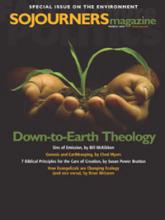THE AMAZON BASIN remains relatively intact, having lost only 20 percent of its original forests. That fact may sound reassuring; after all, many critical ecosystems around the globe already have lost more than 70 percent of their native environment. The Amazon's apparent stability can be misleading due to its vast size; it loses more than 17,000 square kilometers to deforestation each year.
Last summer I made a trip up the Amazon basin in Peru. My traveling companions: four students from the University of San Francisco. Our mission: Find out how to save the Amazon from destruction.
Three Peruvians, who rely on the natural wealth of the rain forest for their livelihood, became our teachers. A local shaman introduced us to its biological treasure. The Amazon is home to more than 40,000 plant species, with nearly three-fourths of those species found nowhere else on the globe. With machete in hand, the shaman carved a virgin path through the rain forest, stopping periodically to hold up a plant and explain its medicinal properties. When a nasty wasp stung two of us, the shaman congratulated us, saying it would help mitigate the future contraction of arthritis.
While corporate logging interests represent a large threat to the rain forest, the massive influx of small farmers who stake their claim in the rain forest is even more problematic. Most farmers harvest timber as part of their income; the cumulative effect is significant.
We cringed as one "lumberjack" showed us the environmental impact of logging on his parcel of rain forest. He explained that the timber sales enable him to buy clothes and send his children to school. Any environmental movement seeking to conserve the rain forest has to come up with an alternative for this lumberjack, along with the hundreds of thousands like him.
Read the Full Article

